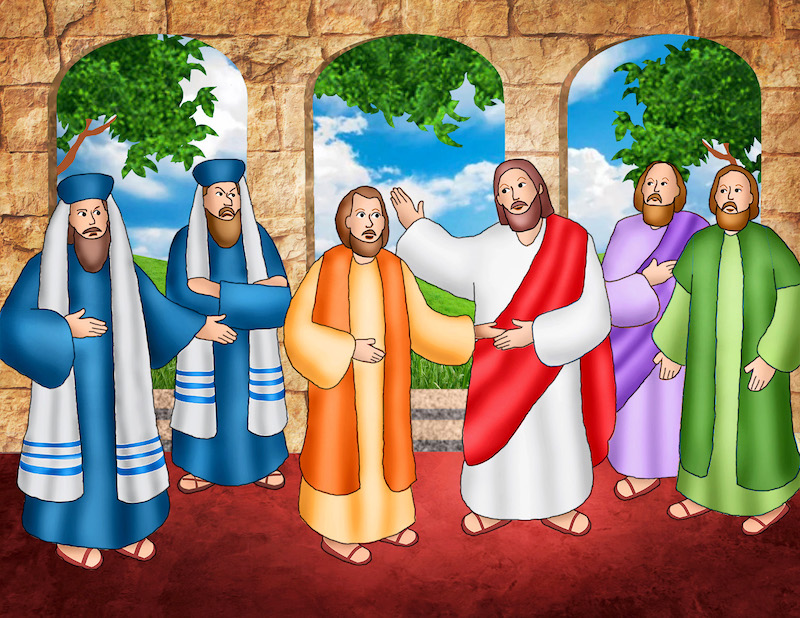Jesus returned to Galilee after spending 40 days in the desert. He traveled all around the area, healing those who were sick and calling people to follow him.
One day, Jesus and his apostles were walking through a field of grain. It was the Sabbath, a day of rest on which no work was to be done.
As they walked through the field, Jesus’ followers picked the heads of grain, rolled them between their hands and ate them.
The Pharisees noticed this and questioned Jesus.
“Why are you doing what is unlawful on the Sabbath?” they asked.
Jesus reminded the Pharisees what David had done in 1 Samuel 21:1-6.
David was fleeing King Saul, who wanted to harm him. During his flight, David stopped and asked the priest of Nob for five loaves of bread, but the priest only had holy bread to give him.
“Have you not read what David did when he and those (who were) with him were hungry? He went into the house of God, took the bread of offering, which only the priests could lawfully eat, ate of it and shared it with his companions,” Jesus said.
“The Son of Man is lord of the Sabbath,” he added.
On another Sabbath, Jesus was teaching in the synagogue. One of the men who was there had a withered right hand.
After the incident with the grain, the Pharisees and scribes were watching Jesus very closely to see if he would cure someone on the Sabbath. If he did, they were ready to accuse him of wrongdoing.
Jesus knew what the Pharisees and scribes were up to.
He turned to the man with the withered hand.
“Come up and stand before us,” he said.
Jesus addressed the people he had been teaching.
“I ask you, is it lawful to do good on the Sabbath rather than to do evil, to save life rather than to destroy it?” he asked.
Jesus turned back to the man.
“Stretch out your hand,” Jesus told him.
The man stretched out his hand, and the withered hand was restored.
The Pharisees and scribes became enraged and began to discuss what they could do to Jesus.
READ MORE ABOUT IT:
Luke 6
Q&A
- Who accused Jesus and the apostles of doing something unlawful?
- Whom did Jesus cure on the Sabbath?
ESSAY: Describe how you keep the Sabbath holy.
BIBLE ACCENT:
In Mark 2:27, Jesus said, “The Sabbath was made for man, not man for the Sabbath.”
What does this mean?
In Exodus 20:8-11, we read that the Third Commandment says to “remember the Sabbath day — keep it holy.” God had created the world in six days and rested on the seventh, and he wanted his people to have a day of rest as well.
“You shall not do any work, either you, your son or your daughter, your male or female slave, your work animal, or the resident alien within your gates,” God said.
Over time, the Jewish leaders created stricter and stricter rules regarding what activities were prohibited on the Sabbath. Curing people on the Sabbath broke those strict rules.
Jesus had a different view — the Sabbath was meant to be a blessing from God to his people instead of a day for following burdensome, man-made rules.
In Matthew 12:11-12, Jesus told the Pharisees why he cured on the Sabbath.
“Which one of you who has a sheep that falls into a pit on the Sabbath will not take hold of it and lift it out?” he asked. “How much more valuable a person is than a sheep. So it is lawful to do good on the Sabbath.”
SAINT FOR TODAY:
St. Thérèse Couderc
Marie-Victoire Couderc was born to a French farm family in 1805.
When she grew up, she joined a new religious teaching order and took the name Thérèse. Instead of teaching, she was sent to manage a mountain hostel for women pilgrims at the shrine of St. John Francis Regis.
Under her guidance, the hostel became a successful retreat house. The order decided to separate into a teaching ministry called the Sisters of St. Regis and a retreat ministry called the Congregation of Our Lady of the Cenacle.
St. Thérèse was superior of the Cenacle sisters until 1838. She died in 1885, and we remember her on Sept. 26.
PUZZLE:
Using the hints provided, put a T next to the true sentences about Jesus healing people and an F next to the ones that are false. If a sentence is false, put the correct answer on the line at the end of the sentence.
- ___ Jesus healed Peter’s father. _______ (Matthew 8:14-15)
- ___ Jesus healed a paralytic. _______ (Matthew 9:6-7)
- ___ Jesus healed three blind women. _______ (Matthew 9:27-30)
- ___ Jesus healed 10 lepers. _______ (Luke 17:12-14)
Answers: 1. F (mother-in-law); 2. T; 3. F (two blind men); 4. T

